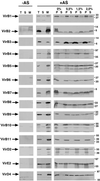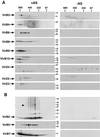Detergent extraction identifies different VirB protein subassemblies of the type IV secretion machinery in the membranes of Agrobacterium tumefaciens
- PMID: 12177443
- PMCID: PMC123269
- DOI: 10.1073/pnas.172390699
Detergent extraction identifies different VirB protein subassemblies of the type IV secretion machinery in the membranes of Agrobacterium tumefaciens
Abstract
The VirB/D4 type IV secretion system of Agrobacterium tumefaciens translocates virulence factors (VirE2, VirF, and the VirD2-T-DNA complex) to plant cells. The membrane-bound translocation machinery consists of 12 proteins (VirB1-11 and VirD4) required for substrate translocation. Protein-protein interactions in the membranes were analyzed after extraction with the mild detergent dodecyl-beta-d-maltoside followed by separation under native conditions. Incubation of the membranes with increasing concentrations of the detergent differentially extracted virulence proteins. Separation of the solubilized proteins by blue native electrophoresis revealed cofractionation between two classes of protein complexes containing VirB7. The first class, consisting of major T-pilus component VirB2 and associated proteins VirB5 and VirB7, comigrated in the low molecular mass portion of the gel of about 100 kDa. The second class contains putative translocation complex core components VirB8, VirB9, and VirB10 in the high molecular mass portion of the gel larger than 232 kDa, as well as VirB7. Solubilized proteins were characterized further by gel filtration chromatography. This procedure separated T-pilus-associated proteins VirB2, VirB5, and VirB7 in the low molecular mass range from the other components of the translocation machinery and the substrates VirE2 and VirD2. Fractionation of VirB7-containing complexes (VirB7-VirB7 homodimers and VirB7-VirB9 heterodimers) suggested that they may link the T-pilus components to the core of the translocation machinery. Based on previously described VirB protein interactions and biochemical analysis of C58 wild type as well as of virB5 and virB6 deletion mutants, a model of T-pilus assembly in A. tumefaciens is suggested.
Figures






Similar articles
-
Agrobacterium tumefaciens VirB6 protein participates in formation of VirB7 and VirB9 complexes required for type IV secretion.J Bacteriol. 2003 May;185(9):2867-78. doi: 10.1128/JB.185.9.2867-2878.2003. J Bacteriol. 2003. PMID: 12700266 Free PMC article.
-
Elevated temperature differentially affects virulence, VirB protein accumulation, and T-pilus formation in different Agrobacterium tumefaciens and Agrobacterium vitis strains.J Bacteriol. 2001 Dec;183(23):6852-61. doi: 10.1128/JB.183.23.6852-6861.2001. J Bacteriol. 2001. PMID: 11698374 Free PMC article.
-
VirB7 lipoprotein is exocellular and associates with the Agrobacterium tumefaciens T pilus.J Bacteriol. 2001 Jun;183(12):3642-51. doi: 10.1128/JB.183.12.3642-3651.2001. J Bacteriol. 2001. PMID: 11371529 Free PMC article.
-
Assembly of the VirB transport complex for DNA transfer from Agrobacterium tumefaciens to plant cells.Curr Opin Microbiol. 1998 Dec;1(6):649-55. doi: 10.1016/s1369-5274(98)80110-0. Curr Opin Microbiol. 1998. PMID: 10066547 Review.
-
VirB8: a conserved type IV secretion system assembly factor and drug target.Biochem Cell Biol. 2006 Dec;84(6):890-9. doi: 10.1139/o06-148. Biochem Cell Biol. 2006. PMID: 17215876 Review.
Cited by
-
Identification of Bartonella Trw host-specific receptor on erythrocytes.PLoS One. 2012;7(7):e41447. doi: 10.1371/journal.pone.0041447. Epub 2012 Jul 26. PLoS One. 2012. PMID: 22848496 Free PMC article.
-
MtNODULE ROOT1 and MtNODULE ROOT2 Are Essential for Indeterminate Nodule Identity.Plant Physiol. 2018 Sep;178(1):295-316. doi: 10.1104/pp.18.00610. Epub 2018 Jul 19. Plant Physiol. 2018. PMID: 30026291 Free PMC article.
-
Conjugative coupling proteins interact with cognate and heterologous VirB10-like proteins while exhibiting specificity for cognate relaxosomes.Proc Natl Acad Sci U S A. 2003 Sep 2;100(18):10465-70. doi: 10.1073/pnas.1830264100. Epub 2003 Aug 18. Proc Natl Acad Sci U S A. 2003. PMID: 12925737 Free PMC article.
-
Cag type IV secretion system: CagI independent bacterial surface localization of CagA.PLoS One. 2013 Sep 10;8(9):e74620. doi: 10.1371/journal.pone.0074620. eCollection 2013. PLoS One. 2013. PMID: 24040297 Free PMC article.
-
Growth conditions determine the DNF2 requirement for symbiosis.PLoS One. 2014 Mar 14;9(3):e91866. doi: 10.1371/journal.pone.0091866. eCollection 2014. PLoS One. 2014. PMID: 24632747 Free PMC article.
References
-
- Lessl M. & Lanka, E. (1994) Cell 77, 321-324. - PubMed
-
- Salmond G. P. C. (1994) Annu. Rev. Phytopathol. 32, 181-200.
-
- Covacci A., Telford, J. L., Del Giudice, G., Parsonnet, J. & Rappuoli, R. (1999) Science 284, 1328-1333. - PubMed
-
- Baron C., O'Callaghan, D. & Lanka, E. (2002) Mol. Microbiol. 43, 1359-1366. - PubMed
Publication types
MeSH terms
Substances
LinkOut - more resources
Full Text Sources
Other Literature Sources
Research Materials

